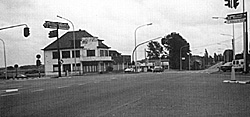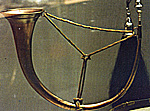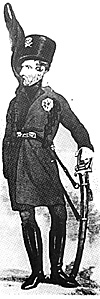Quatre Bras 1815
Les Quatre Bras - the four arms - was the point where the Nivelles to Namur road crossed the main Charleroi-Brussels highway. Around Namur and Charleroi were stationed Blucher's 128,000 Prussians; between Brussels, Mons, and Nivelles lay Wellington's 107,000 British, Dutch,
Belgian, and German troops. Together Blucher's and Wellington's combined forces were far stronger than Napoleon's L'Armee du Nord. but if either the Prussians or the Anglo-Dutch were caught separately they ran the risk of being overwhelmed. This the importance of Quatre Bras. If the French siezed the crossroads, communications between the two Allied armies would be severed and Napoleon's victory all but assured. [5]
The Brunswickers marched until they reached the village of Waterloo where they were allowed a brief rest, and then they proceeded onto Genappe where they again halted. Shortly after their arrival at Genappe Picton's 5th Division, which was also part of the Reserve, marched through the town en route for Quatre Bras and the Brunswickers soon followed.
The 5th Division, with the Brunswick Corps close behind, arrived at Quatre Bras sometime between 14:30 and 14:45 hours. The Brunswick Corps was not complete as the 1st and 3rd Leichte-Bataillone and the artillery, which had been cantoned some miles beyond the other Brunswick troops, were still on the march. The strengths of those present was:
The 1st and 2nd Dutch-Belgian divisions still
occupied the ground in front of the crossroads but the
French 5th, 6th, and 9th infantry divisions and the 2nd
Cavalry Division, under the command of Marshal Ney, had
already pushed back the Dutch forces on the right of the
Allied position and were preparing to attack the crossroads.
Upon their arrival the two Jager companies of the
Avantgarde were sent into the Bois de Bossu to support the
failing right wing, whilst the 2nd Leichte-Bataillon was
detached along the Namur road to assist the British 95th
Rifles who held the extreme left of the Allied line. The rest of
the Brunswickers deployed in the rear of, and parallel to, the
Namur-Nivelles road, forming a reserve to Picton's Division.
[6]
Despite the arrival of the Reserve Wellington was still
considerably outnumbered, but he knew that almost the
whole of his army was marching upon Quatre Bras All he
needed was time. So, instead of waiting to be attacked,
Wellington moved onto the offensive. Brunswick was
ordered to lead the advance towards the farm of
Gernioncourt at the centre of the French position. Picton's
Division was to support Brunswick to the east of the
Charleroi road.
With the two light companies of the Avantegarde in
skirmish order to the front and extended to the right to link
up with the Jagers, the Duke led the LeibBataillon and the Ist
LinienBataillon forward in columns abreast, (or possibly in
square), with the Hussars and the Uhlans following
immediately in the rear. The 2nd and 3rd Linien-Bataillon
formed a third line which remained at the crossroads.
The French infantry of Bachelu's Division
was driven back by Picton's brigades marching in
line through the tall fields of rye. But a devastating
charge by Pire's 5th and 6th Lancers halted Picton's
advance, and Wellington ordered the 5th Division to
retire upon the Namur road. With Picton's
withdrawal the Brunswick corps, which had
progressed some distance towards Gemioncourt,
now found itself facing the French centre alone.
From the heights to the west of Gemioncourt, the
french poured a heavy fire upon the exposed
Germans. Repeated salvoes from french cannon and
incessant discharges from flocks of skirmishers tore
into the ranks of the Brunswickers. [7]
The Brunswick Corps doggedly held its ground with
the Duke calmly riding up and down in front of the line
Quietly smoking his pipe. But the French 6th Division - led
by Jerome Bonaparte the man who had once ruled over the
Duke's lands - began to progress along the edge of the
Bossu wood supported by Fire's cavalry which was again
moving in force down the Charleroi road. Brunswick's bold
advance had delayed the French attack and bought
Wellington a little of the time he so desperately needed. But
the Duke's position was becoming increasingly perilous
and Brunswick appealed to Wellington for artillery support
as his own guns had still not arrived. Wellington obliged by
ordering a British battery to assist the Brunswickers. Four guns were sent forward and
posted on the right of the Brunswick line. This move
prompted the French gunners to re-double their efforts and
two of the British guns were disabled. [8]
Jerome's infantry continued to advance, driving back
the two Light Companies and pressing in upon the
Brunswick right flank. Brunswick's advanced position was
now clearly untenable. His small force was some 800 Yards
ahead of the main Allied line and in danger of being cut off.
The Duke had no choice but to withdraw. The Hussars were
still stationed behind the infantry and in their rear was a
curve in the Bossu wood which was "in some parts
intricate" and impassable for cavalry. To save them from
being trapped against the trees Brunswick ordered the
Hussars to move to their left across the Charleroi road and
withdraw toward the Allied positions along the Namur road
He then sent the 1st Linien-Bataillon back down the
Charleroi road to Quatre Bras and the Leib-Bataillon across
the field to follow the Hussars, leaving the two disabled
pieces to the enemy. To cover the retreat, the Duke placed
himself at the head of the Uhlans and charged the advancing
French skirmishers.
The 1st Linien-Bataillon retired in good order but the
Leib-Bataillon, moving directly across the line of fire of the
artillery near Gemioncourt and under pressure from the
French light troops, broke formation and ran towards the
crossroads. The Uhlans, their charge easily beaten off by
Jerome's men, also turned and galloped back towards
Ficton's line with Pire's cavalry in hot pursuit.
As the Duke was trying to rally his frightened troops he was shot
through the body and fell from his horse, which had also
been hit. He died a few moments later and command of the
Brunswick Corps devolved upon Oberst Olfermann. [9]
The panic-stricken Bttn and Uhlans fled towards
Quatre Bras, wher ethe 92nd Highlanders wheeled one
company back, let the confused mass through, and reformed
in time to repulse the French Chasseurs. As the french light
cavalry pulled back, Wellington pulled the Brunswick
Hussars forward, but Pire's troopers charged again and
crashed into the unsuspecting 42nd and 44th regiments
whilst the Chasseurs chased the retreating Brunswicker
Hussars.
Wellington, who was in front of Pack's Brigade,
suddenly found himself in danger of being ridden down by
the on-rushing cavalry and he had to follow the example of
the Hussars and gallop for his life. As he neared the Namur
road he called out to the red-coats lining the road,
"Ninetysecond, lie down", and he jumped his horse over
the Highlanders. [10]
The Allied infantry was caught unprepared and the
French horsemen pressed home their attack before many of
the British and Hanoverian battalions could form square The
3rd Linien-Bataillon, which had remained stationed along the
Nivelles road to the west of Quatre Bras was only saved
from destruction by the Uhlans who held off the Chasseurs
until the battalion formed to receive cavalry. Eventually
Fire's cavalry withdrew only to be reinforced by a brigade of
General Kellerman's 11th Cuirassier Division. Together Pire's
and Kellerman's cavalry charged the Allied line but the
element of surprise had gone and the French horsemen were
repulsed with considerable loss. [11]
Jerome's infantry in the Bois de Bossu had virtually
cleared the wood of Allied troops and the brigades of
Bauduin and Jamin, and Gauthier' 9 brigade of Foy's 9th
Division began to close upon Wellington's right flank. To
counter this threat the Leib-Eataillon and the 2nd Linien
were moved in front of Quatre Bras ahead of the main Allied
positions. At this point in the action, as the French cavalry
were preparing to re-new their Assault and the artillery near
Cernioncourt had re-commenced their bombardment of the
crossroads, the first units of Allen's 3rd Division arrived on
the field.
After detaching one battalion to assist Pack's
depleted brigade, which was running desperately short of
ammunition, Alten was instructed to retake the wood and
support the Leib-Hataillon and the 2nd Linien who were
starting to fall back under pressure from Jerome's and Foy's
regiments. The Brunswickers rallied along the line of a ditch
which ran across the narrowest part of the wood where they
were joined by Halkett's Brigade of the 3rd Division.
Ney had sent two companies of artillery along the
eastern edge of the wood and as they closed upon Quatre
Bras they halted and poured a heavy fire upon the
Brunswick battalions. At this moment Lloyd's brigade of
foot artillery arrived at the cross roads. "I was directed to
follow the four other guns of Major Lloyd's Battery ordered
into action in front of the farm of Quatre Bras, on the
Charleroi road, to support the Duke of Brunswick". Recalled
Major Rudyard. Lloyd's 9-pounders took up a position on
the right of the Brunswick line, but "before we unlimbered
some three or four horses of each Gun and wagon were
killed, some wheels disabled, and literally some of our
gunners were cut in two, for we were not more than from
four to five hundred yards from the Enemy's Batteries."
[12]
Urged on by a desperate dispatch from Napoleon,
Ney ordered his cavalry to charge the Allied line yet again.
"The fate of France is in your hands" Kellerman was told.
"'Take your cavalry and ride them down." The two regiments
of Cuirassiers succeeded beyond all reasonable
expectations, overwhelming one British battalion and forcing
two others to run for cover in the wood. Though
Wellington's position had never been more precarious, the
battle was already slipping away from Ney. The 1st and 3rd
Liechte Bataillone with the horse and foot artillery under
Major Mahn marched onto the field followed by the British
Guards Division, Giving Wellington an appreciable
numerical advantage for the first time in the battle. The
Brunswick battalions stood firm against the French cavalry
and as the latter retired wellington ordered a general
advance.
All along the line the Allies advanced with the 2/1st
Guards penetrating the Bois de Rossu and the 1st and 3rd
Biechte-Hataillone skirting the wood on the Guards' left flank
ahead of Halkett's Brigade. The 1st Guards met with stiff
resistance and it was not until the regiments 3rd Battalion
joined them that they were able to make any real progress.
The Guards pushed through the wood and back on into the open and the Leib-Bataillon took over the post on the Guards' flank. As the Leib-Bataillon manoeuvred into position on the Guards' left the French cavalry counter-attacked.
The Guards ran back to line the ditch on the perimeter of the wood and the Leib Bataillon threw itself into square, "and received the cavalry with a degree of coolness, steadiness and gallantry, which won for it the warmest admiration and encomiums of the British who witnesssed the manoeuvre." The cavalry were driven off, and as night began to fall Ney withdrew his troops to the village of Frasnes.
The Battle of Quatre Bras was over. "The troops of the 5th division, and those of the Bruswick Corps were long and severely engaged, and conducted themselves with the utmost gallantry." Wrote Wellington to the Earl of Bathurst on 19 June. "Our loss was great, as your Lordship will perceive by the enclosed return, and I have particularly to regret His Serene Highness the Duke of Brunswick, who fell fighting at the head of his troop." [14]
RETURN OF KILLED,WOUNDED, AND MISSING,
OF THE BRUNSWICK TROOPS AT THE BATTLE OF
QUATRE BRAS
[1] Also, confusingly, called
Braunschweig-Wolfenbuttel-Oeis, Braunschweig actually formed part of the
territory of the Electorate of Hanover. For more details see G. Nafziger,
Napoleon's German Enemies, 1991, p1, and 0. von Pivka, Brunswick Troops
1809-15, 1985, p.3. The Duke was a brother in-law to Frederick the Great and he
married Princess Augusta, the sister of George II of England. D. Barnes,
Ferdinand Duke of Brunswick And Luneburg, Eighteenth Century Military
Notes and Queries, no. 10, p. 10.
This being ascertained by midnight, not to be the case, the reserve received orders
to traverse the wood of Soignies." Lieut.General W. Gomm wrote that the Reserve was ordered to assemble "during the night, and march at five o'clock next morning." H.T. Siborne, Waterloo Letters, 1891, p.23. D.Hamilton-Williams (Waterloo, New Perspectives, 1993, p.403) cautiously gives the time of the preparatory orders as between 17:00 and 21:00 hours.
Beamish, ibid, vol.II p.326 gives no definite time for the receipt of the news of the French advance but he endorses Muffling's statement that Wellington waited until midnight before issuing his secondary orders.
The Brunswick Corps at Quatre Bras
 The crossroads of Quatre Bras, looking down the Charleroi road towards Getmoncourt. The Namur road runs away to the left of the picture.
The crossroads of Quatre Bras, looking down the Charleroi road towards Getmoncourt. The Namur road runs away to the left of the picture.
Avantgarde 672 men
Leichte-Infanterie1,344
Linien-Infanterie2,016
Husaren-Regiment 690
Uhlan 232
Feldgendarmerie 17
Total: 4,771 A Brunswick Jager bugle-horn on display in the Braunschwiegisches Landesmuseum
A Brunswick Jager bugle-horn on display in the Braunschwiegisches Landesmuseum
 The Duke of Brunswick (from Ackermann's Repository of Arts)
The Duke of Brunswick (from Ackermann's Repository of Arts)
Regiment Killed
Wounded Missing General staff 1 - - Husaren 17 29 - Uhlan 4 10 - Artillery - - - Avantgarde 9 47 - Leib-Bataillon 15 111 - 1st Leichte -
3 - 2nd Leichte 18
52 - 3rd Leichte - -
- 1st Linien 17 88
- 2nd Linien 25 166
- 3rd Linien 4 20
- Totals 110 526
210 Footnotes
[2] This was the name by
which they were known to their British allies, but their correct title was the
Braunschweig Launburg'sche Jager, von Pivka, ibid p37. See also C.Oman,
Wellington's Army, 1809-14, 1913, pp.224-5. The young Duke's title was Duke
of BraunschweigLuneberg, Oels and Bernstadt. C.N.L. Beamish, History of the
King's German Legion, 1832-7, vol. II , pp. 332-3
[3] Nafziger, ibid, pp.82-
90 The Dispatches of Field Marshal the Duke of Wellington, 1834-8, vol.12,
p.327.Peter Hofschroer, in his book, '1815 The Waterloo Campaign', p78, gives
the strength of the Brunswick Corps as 7,380.
[4] The actual time that
Wellington received definite information about the French advance is still the
subject of some debate, as is the timing of his movement orders. Wellington's
prepatory movement orders printed in Wellington's dispatches (vol. 12, pp.472-3)
are dated but not timed. C.von Muffling, the Prussian liaison officer attached to
Wellington's head quarters in his history of the Campaign in the Year 1815,
1816,pp. 1-2, states that the news reached Wellington-at halfpast four PM, and "at
six o'clock P.M. the Duke of Wellington gave orders for the whole army to keep in
readiness to march; awaiting, however, whether reports from Mons should
announce the advance of any of the enemy's columns in that Quarter.
[5] The reader is asked to
accept this very simplistic view of the strategical situation for the purpose of
brevity. For more detail see Wellington's Dispatches, vol. 12, pp.295-7, 304-5,
324-6, 337-8,35961; Wellington's supplementary Dispatches, vol. X, pp.513-31,
Hamilton-Williamas pp.97-110; Napoleon Bonaparte The Waterloo Campaign (
trans . S de Chair) 1957, pp.67-81.
[6] W.Siborne, The
Waterloo Campaign 1815, 1894, pp.328-9; Hamilton-Williams, pp.205-6.
[7] W. Siborne, p.14-76;
H.T. Siborne, p.24.
[8] I am unable to determine which battery
this was. The most likely were Bolton's British or Sympher's King's German
Legion foot brigades as both of these were attached to the 5th Division, but there
were also two Netherlandish batteries in the field at the time, J.Fortescue, A
History of the British Army,1920, vol.X, p.427. Hamilton-Williams (New
Perspectives, p.206) transforms this battery into the Brunswick horse artillery.
But as Beamish (vol.11, p.331) points out the Brunswick artillery had been
quartered at Assche, nine or ten miles beyond Brussels, "and could not, therefore,
receive the order of march in time to admit of their coming up with the rest of the
corps" see also Waterloo Letters,P-24
[9] The Duke was 44 years old. His last
words were reported as being, "my dear Wacholtz, where is Offermann?" Major
Wacholtz was Brunswick's staff officer who was with him when he was shot and
Colonel (Oberst) Offermann was his brigadier. Nafziger, p 84; von Pivka, pp.21-
2; W. Siborne, p.78.
[10] W.H. Fitchett, How England Saved
Europe, 1900, vol.1V, pp. 171-2; E. Longford, Wellington The Years of the
Sword, 1969, p.428; Fortescue, vol X, p.309.
[11] Fortescue, pp.305-12; W. Siborne,
pp.79-82. 12. Waterloo Letters, p.231, W.Siborne, p.90.
[12] New Perspectives, p.219. Fortescue,
p.315, states that the Guards arrived before the Brunswickers.
[14] W.Siborne, p. 101;
Wellington's Dispatches, vol.12, p.482.
[15] W. Siborne, p.555;
Wellington's Dispatches, vol.12.
Introduction and Background
Brunswick Army 1815
Battle of Quatre Bras
The Brunswick Memorial
Large Map of Quatre Bras Area (slow: 186K)
Brunswick Uniforms 1815 (slow: 104K)
Back to Table of Contents -- Age of Napoleon #32
Back to Age of Napoleon List of Issues
Back to MagWeb Master Magazine List
© Copyright 1999 by Partizan Press.
This article appears in MagWeb (Magazine Web) on the Internet World Wide Web. Other military history articles and gaming articles are available at http://www.magweb.com